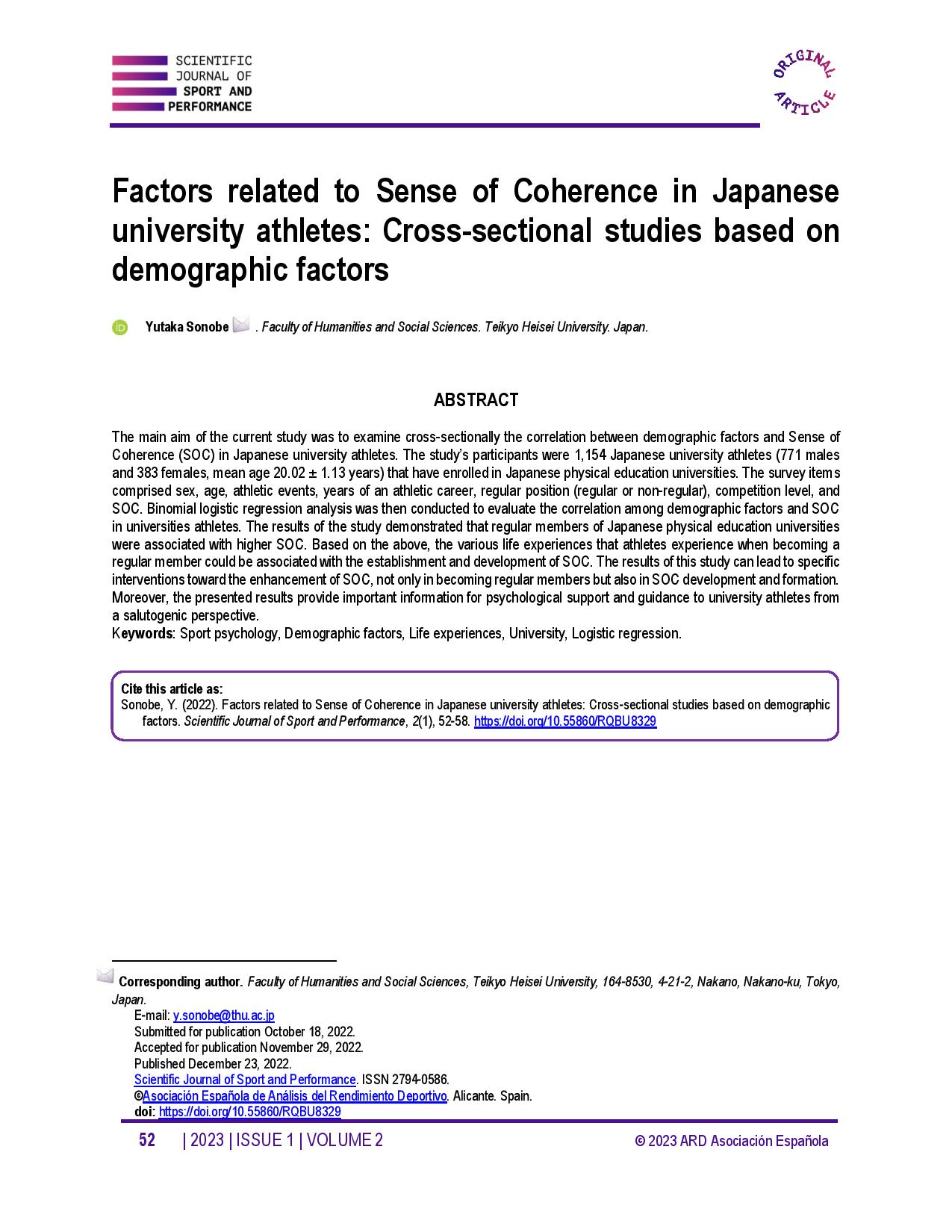Factors related to Sense of Coherence in Japanese university athletes Cross-sectional studies based on demographic factors
Main Article Content
Abstract
The main aim of the current study was to examine cross-sectionally the correlation between demographic factors and Sense of Coherence (SOC) in Japanese university athletes. The study’s participants were 1,154 Japanese university athletes (771 males and 383 females, mean age 20.02 ± 1.13 years) that have enrolled in Japanese physical education universities. The survey items comprised sex, age, athletic events, years of an athletic career, regular position (regular or non-regular), competition level, and SOC. Binomial logistic regression analysis was then conducted to evaluate the correlation among demographic factors and SOC in universities athletes. The results of the study demonstrated that regular members of Japanese physical education universities were associated with higher SOC. Based on the above, the various life experiences that athletes experience when becoming a regular member could be associated with the establishment and development of SOC. The results of this study can lead to specific interventions toward the enhancement of SOC, not only in becoming regular members but also in SOC development and formation. Moreover, the presented results provide important information for psychological support and guidance to university athletes from a salutogenic perspective.
Article Details

This work is licensed under a Creative Commons Attribution-NonCommercial-ShareAlike 4.0 International License.
References
Antonovsky, A. (1979). Health, stress, and coping/Aaron Antonovsky. Jossey-Bass Publishers.
Antonovsky, A. (1987). Kenko-no-nazo-wo-toku [Unraveling the mystery of health: how people manage stress and stay well] Y. Yamazaki & K. Yoshii (Trans.). Yushindo Kobunsha. https://doi.org/10.4135/9781446221129.n9 DOI: https://doi.org/10.4135/9781446221129.n9
Arai, H., Sugimoto, T., Masuda, M., Kamano, S., & Tokuyasu, A. (2021). Sport-life balance and mental health in university student-athletes: A comparative study by admissions pathway. Journal of Japan Society of Sports Industry, 31(3), 3_341–3_349. https://doi.org/10.5997/sposun.31.3_341 DOI: https://doi.org/10.5997/sposun.31.3_341
Endo, S., Kanou, H., & Oishi, K. (2012). Sports activities and sense of coherence (SOC) among college students. International Journal of Sport and Health Science, 10, 1–11. https://doi.org/10.5432/ijshs.201114 DOI: https://doi.org/10.5432/ijshs.201114
Gouttebarge, V., Castaldelli-Maia, J. M., Gorczynski, P., Hainline, B., Hitchcock, M. E., Kerkhoffs, G. M., Rice, S. M., & Reardon, C. L. (2019) Occurrence of mental health symptoms and disorders in current and former elite athletes: A systematic review and meta-analysis. British Journal of Sports Medicine, 53(11), 700–706. https://doi.org/10.1136/bjsports-2019-100671 DOI: https://doi.org/10.1136/bjsports-2019-100671
Höge, T., & Büssing, A. (2004). The impact of sense of coherence and negative affectivity on the work stressor—Strain relationship. Journal of Occupational Health Psychology, 9(3), 195–205. https://doi.org/10.1037/1076-8998.9.3.195 DOI: https://doi.org/10.1037/1076-8998.9.3.195
Kanda, Y. (2013). Investigation of the freely available easy-to-use software “EZR” for medical statistics. Bone Marrow Transplantation, 48(3), 452–458. https://doi.org/10.1038/bmt.2012.244 DOI: https://doi.org/10.1038/bmt.2012.244
Kimura, A., Tezuka, Y., & Sugiyama, Y. (2013). The relationship between stressors and burnout in college athletes. Journal of Health Sciences, 35, 25–31. https://doi.org/info:doi/10.15017/27206
Larson, G. A., Starkey, C., & Zaichkowsky, L. D. (1996). Psychological aspects of athletic injuries as perceived by athletic trainers. Sport Psychologist, 10(1), 37–47. https://doi.org/10.1123/tsp.10.1.37 DOI: https://doi.org/10.1123/tsp.10.1.37
Mayer, J., & Thiel, A. (2014). Health in elite sports from a salutogenetic perspective: Athletes’ sense of coherence. PLOS ONE, 9(7), e102030. https://doi.org/10.1371/journal.pone.0102030 DOI: https://doi.org/10.1371/journal.pone.0102030
Richardson, C. G., & Ratner, P. A. (2005). Sense of coherence as a moderator of the effects of stressful life events on health. Journal of Epidemiology and Community Health, 59(11), 979–984. https://doi.org/10.1136/jech.2005.036756 DOI: https://doi.org/10.1136/jech.2005.036756
Sagy, S., & Antonovsky, H. (2000). The development of the sense of coherence: A retrospective study of early life experiences in the family. International Journal of Aging and Human Development, 51(2), 155–166. https://doi.org/10.2190/765l-k6nv-jk52-ufkt DOI: https://doi.org/10.2190/765L-K6NV-JK52-UFKT
Skirka, N. (2000). The relationship of hardiness, sense of coherence, sports participation, and gender to perceived stress and psychological symptoms among college students. Journal of Sports Medicine and Physical Fitness, 40(1), 63–70.
Storch, E. A., Storch, J. B., Killiany, E. M., & Roberti, J. W. (2005). Self-reported psychopathology in athletes: A comparison of intercollegiate student-athletes and non-athletes. Journal of Sport Behavior, 28(1), 86–98.
Togari, T., Yamazaki, Y., Nakayama, K., Kimura Yamaki, C., & Sasaki Takayama, T. (2008). Construct validity of Antonovsky’s sense of coherence scale: Stability of factor structure and predictive validity with regard to the well-being of Japanese undergraduate students from two-year follow-up data. Japanese Journal of Health and Human Ecology, 74(2), 71–86. https://doi.org/10.3861/jshhe.74.71 DOI: https://doi.org/10.3861/jshhe.74.71
Tokunaga, M., Hashimoto, K., & Takayanagi, S. (1994). A study of “traits” and “state” of athletes’ psychological performance levels: Regarding the players participating in the semirigid baseball tournament. Journal of Health Sciences, 16, 65–73. https://doi.org/info:doi/10.15017/610
Uematsu, Y., Ito, M., Gushiken, T., & Suzukawa, K. (2021). Reasons for early withdrawal of Japanese top youth gymnasts. Journal of Physical Exercise and Sports Science, 26(2), 111–118.
Walker, I., Brierley, E., Patel, T., Jaffer, R., Rajpara, M., Heslop, C., & Patel, R. (2022). Mental health among elite sportspeople: Lessons for medical education. Medical Teacher, 44(2), 214–216. https://doi.org/10.1080/0142159X.2021.1994134 DOI: https://doi.org/10.1080/0142159X.2021.1994134




